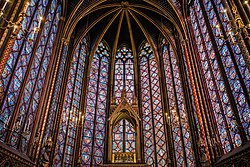
Back Gotiese kuns Afrikaans Gotik ALS Arte gotico AN فن قوطي Arabic فن قوطى ARZ Arte góticu AST Qotik Azerbaijani Gotik BAR Готыка Byelorussian Готыка BE-X-OLD
Top: The Western (Royal) Portal of the Chartres Cathedral (circa 1145), these architectural statues being the earliest Gothic sculptures and a revolution in style and the model for a generation of sculptors; Centre: The Sainte-Chapelle from Paris (1194-1248); Bottom: The Wilton Diptych (1395–1459) | |
| Years active | Late 12th century-16th century |
|---|---|
Gothic art was a style of medieval art that developed in Northern France out of Romanesque art in the 12th century AD, led by the concurrent development of Gothic architecture. It spread to all of Western Europe, and much of Northern, Southern and Central Europe, never quite effacing more classical styles in Italy. In the late 14th century, the sophisticated court style of International Gothic developed, which continued to evolve until the late 15th century. In many areas, especially Germany, Late Gothic art continued well into the 16th century, before being subsumed into Renaissance art. Primary media in the Gothic period included sculpture, panel painting, stained glass, fresco and illuminated manuscripts. The easily recognizable shifts in architecture from Romanesque to Gothic, and Gothic to Renaissance styles, are typically used to define the periods in art in all media, although in many ways figurative art developed at a different pace.
The earliest Gothic art was monumental sculpture, on the walls of Cathedrals and abbeys. Christian art was often typological in nature (see Medieval allegory), showing the stories of the New Testament and the Old Testament side by side. Saints' lives were often depicted. Images of the Virgin Mary changed from the Byzantine iconic form to a more human and affectionate mother, cuddling her infant, swaying from her hip, and showing the refined manners of a well-born aristocratic courtly lady.
Secular art came into its own during this period with the rise of cities, foundation of universities, increase in trade, the establishment of a money-based economy and the creation of a bourgeois class who could afford to patronize the arts and commission works, resulting in a proliferation of paintings and illuminated manuscripts. Increased literacy and a growing body of secular vernacular literature encouraged the representation of secular themes in art. With the growth of cities, trade guilds were formed and artists were often required to be members of a painters' guild. As a result, because of better record keeping, more artists are known to us by name in this period than any previous; some artists were even so bold as to sign their names.


